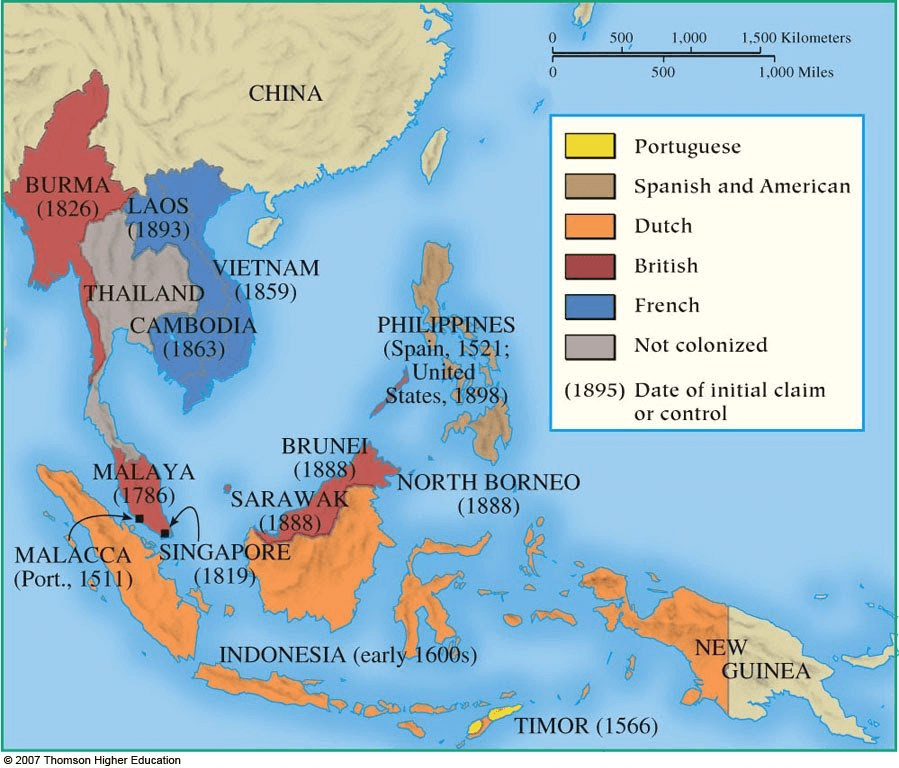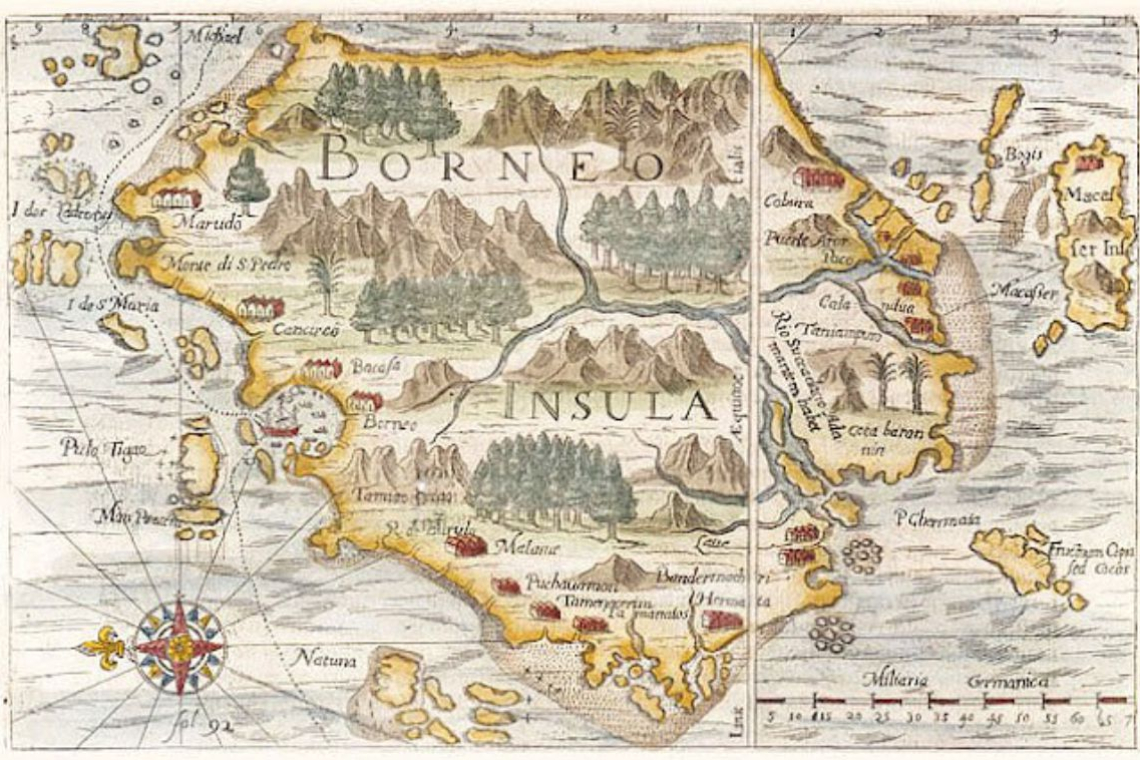Map of Borneo, part of the Sultanate of Brunei. Source: Old World Auctions - Borneo Insula. (n.d.). https://www.oldworldauctions.com/catalog/lot/138/792.
Original Source: De Bry, Theodore. (c.1631). Petits Voyages. Borneo.
The history of the Sulu Sultanate and its neighboring regions is marked by layers of complex political, cultural, and economic exchanges.
Among the most debated issues tied to this history is the sovereignty of North Borneo, particularly the present-day claim to the Sabah region. This debate traces its roots to the 1878 Agreement—a treaty that reshaped the power dynamics of the area. While the agreement is often viewed as a pivotal moment, its implications extend far beyond its original intent, influencing the Sabah Sovereignty dispute, fueling international legal battles, and straining relations between Malaysia and the Philippines. Understanding the region’s historical rulers—from indigenous tribal leaders to successive empires like Brunei, Sulu, Spanish regional influence, and the British Crown —provides valuable context for interpreting the enduring legacy of these territorial and political transitions.
North Borneo’s history is characterized by a complex interplay of indigenous leadership, regional powers, and external colonial influences. The region’s political landscape was shaped by a series of shifting empires, with the local tribes—namely the Kadazan-Dusun, Murut, and Bajao—maintaining a strong sense of autonomy despite the frequent external interventions.
BRUNEI & SULU SULTANATES
The Kingdom of Brunei was the first empire to claim North Borneo, asserting its dominance over the region as early as the 15th century. The Bruneian Sultanate, however, did not seek to impose direct control over the indigenous populations, instead establishing tributary relationships with local leaders. This system of indirect rule allowed the local tribal societies to maintain significant degrees of social, political, and economic autonomy.
In 1673, the Sulu Sultanate gained influence over North Borneo following their support of Sultan Muhyiddin of Brunei in the Battle of Chermin Island, further complicating the region’s political dynamics. The Sulu Sultanate maintained economic and cultural ties with the local tribes, especially through trade, but did not establish full territorial control over the indigenous people, who continued to uphold their independence. Despite the influx of external powers, such as Spain during the 18th century, the tribal leaders of North Borneo were able to maintain a delicate balance, recognizing the authority of the Sultanate but retaining control over their lands and resources.
SPAIN’S INFLUENCE
Spain never directly ruled the Sabah region, but it exerted influence over parts of Borneo during its colonial period from the 16th to 19th centuries. Spain's primary colonial interest in Southeast Asia was focused on the Philippines, yet its proximity to Borneo and involvement in regional trade and politics led it to maintain limited territorial claims over parts of the island. In the 18th century, Spain sought to assert greater authority over the Sulu Archipelago and portions of Borneo, including the area that would later become Sabah. This period of heightened Spanish activity impacted the Sulu Sultanate, particularly weakening the influence of Sultan Jamalul Alam and his successors. Faced with declining authority, the Sultan strategically welcomed British involvement in the region, culminating in the 1878 Agreement. This move was a pragmatic power play by the Sultan to retain some semblance of control, leveraging the British as allies against the weakening Spanish presence. In this context, the British assumed a role in preserving the Sultan's diminishing authority, further shaping the region's political landscape.
The enemy of my enemy is my friend - Fritz Heider
THE BRITISH CROWN
The arrival of the British in the late 19th century marked a turning point in North Borneo’s colonial history. Following the 1878 Agreement between the British North Borneo Company (BNBC) and the Sultan of Sulu, the region transitioned from being under the influence of Spain and the Sulu Sultanate to becoming a British protectorate. This agreement effectively transferred the sovereignty of North Borneo to the British, though the local leaders continued to play an important role in the governance of their respective territories, particularly in rural areas. The power of the Sulu Sultanate, although weakened by Spanish and British presence, still held symbolic significance in the region, as the Sultan continued to receive tribute from the local leaders. The British maintained their colonial authority over North Borneo until the region was ceded to the British Crown in 1946, following the end of World War II.

Map of European Colonies in Southeast Asia. Source: Sutori. (n.d.). Imperialism in Southeast Asia. https://www.sutori.com/en/item/untitled-b5ed-3427.
Original Source: Thomson Higher Education (2007).
THE ROAD TO INDEPENDENCE
The post-World War II period marked a pivotal shift for North Borneo, as it moved toward self-determination after centuries of foreign rule by the Brunei Sultanate, the Sulu Sultanate, and European powers. In 1963, through the Malaysia Agreement, North Borneo, now Sabah, was integrated into the Federation of Malaysia alongside Sarawak and Singapore. Although this transition sparked disputes, particularly with the Philippines, it ended colonial dominance and provided a more unified governance framework. Today, local ethnic communities, particularly the Kadazan-Dusun, Murut, and Bajau, continue to play a significant role in regional governance, maintaining a degree of ethnic and cultural autonomy. While legacies of past powers still influence Sabah, Malaysian independence has provided greater political stability and the opportunity for these communities to shape the region’s future.
REFERENCES
De Miguel, Rafa. (2023, June 22). The Fascinating Tale of a Multimillion-Dollar Lawsuit Featuring Sultans, Oil and a Renegade Lawyer. EL PAÍS English.
Sidik, A. (2022). Tracing the Origin of Sulu claim to North Borneo [Dissertation, Selinus University].
https://www.uniselinus.education/sites/default/files/2023-03/sidik_amde_bin.pdf



